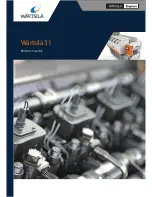
21
EN
L
N
PE
4
3
26
(a)
(b)
(c)
(d)
(e) (f) (g)
(h)
(i)
4
4
3
4
4
4
4
27
(a)
(b)
(c)
Legend
(a)
= Set button
(11)
(b)
= Controller (e.g. 1-pole switch / button)
(c)
= Mains 230 V/50 Hz
(d)
= Socket box
Pin assignment
(e)
=
PE
green / yellow
(f)
=
N
blue
(g)
=
L
black
(h)
=
black (direction of travel 1)
(i)
=
brown (direction of travel 2)
* The grey wire has no function and should be connected
to the neutral terminal.
8.2.1 Controlling the tubular motor using a roller shutter switch
8.2.2 Parallel connection of several motors
It is possible to connect numerous RADEMACHER
tubular motors in parallel. The number of motors to
be connected in parallel is dependent on the capacity
of the switchgear and circuit-breakers.
i
It is not possible to control individual
motors if the equipment is connected in
parallel.
8.2 Electrical connection of the tubular motor
End point setting of tubular motors connected
in parallel:
RolloTube M-line in self-learning mode:
> No end point setting required, see page 23.
RolloTube M-line in parallel connection with
other tubular motors:
> The end points must be set for each other
tubular motor in accordance with the respec-
tive operating manual.
Parallel connection with Venetian blind switch-
es or Venetian blind buttons
Up to five motors can be switched in parallel with
RADEMACHER Venetian blind switches or Venetian
blind buttons.
Parallel connection with RADEMACHER control-
lers (e.g. Troll Comfort)
Please refer to the technical specifications for the
respective number of tubular motors that can be
connected in parallel.
i
When using a switch, we recommend that the mains power to the motor is switched off (switch in zero position)
after reaching the end points. This avoids the motor experiencing sources of interference or excess voltages.
Installation example
Legend
(a)
= Junction box
(b)
= Controller, e.g. 1-pole switch / button
(c)
= Mains 230 V / 50 Hz












































